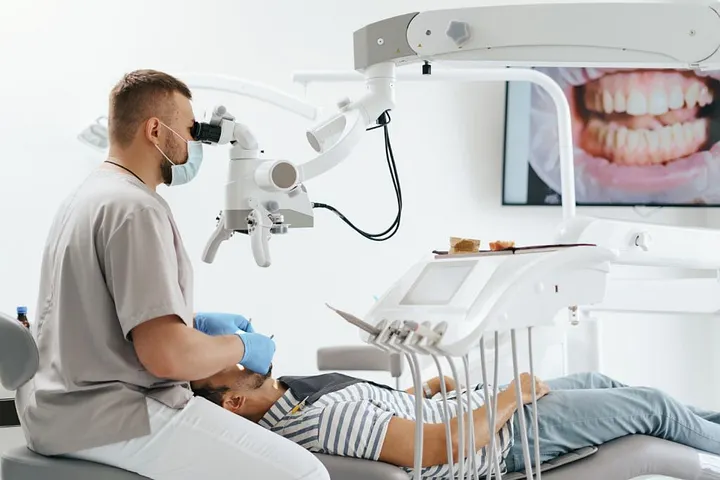How Digital Technology is Transforming Modern Dentistry?
Modern dentistry has undergone a revolutionary transformation through digital technology. From diagnosis to treatment planning, innovation is redefining the patient experience. The shift from manual to digital systems enhances precision, comfort, and speed. This new era empowers both dentists and patients, proving that technology and human care can work seamlessly together for healthier, more confident smiles worldwide.
1. The Rise of Digital Dentistry
- The Shift from Analog to Digital
One of the most significant advancements in dentistry is the move from traditional impression trays to intraoral scanners. These devices capture high-resolution, 3D images of a patient’s mouth within minutes, with no messy molds or gag reflexes. The scans are instantly available for CAD/ CAM (computer-aided design and manufacturing), which fabricates crowns, veneers, and bridges with exceptional precision.
The biggest benefit? Speed and accuracy. In the past, creating a dental crown or bridge could take several days and multiple visits. Now, with digital workflows, dentists can complete the entire process from scanning to milling in just a few hours. For patients seeking a reliable dental clinic, this technology ensures comfort, efficiency, and a truly modern experience.
- Implementing Digital Workflows
Transitioning to digital dentistry is not about collecting fancy tools; it’s about strategic integration. Each new technology requires proper calibration, staff training, and workflow optimization. When executed thoughtfully, digital systems lead to massive improvements in precision and patient satisfaction.
For instance, digital dental implant planning allows dentists to position implants with pinpoint accuracy, minimizing post-procedure discomfort and complications. This makes a huge difference for anyone looking for the best dental implants, offering faster recovery, improved aesthetics, and long-term reliability. Digital workflows make dentistry not only more advanced but also safer and more predictable.
- Safety and Data Responsibility
With technology comes responsibility. Safeguarding patient data is paramount in any digital dental setup. Clinics now use encrypted systems and secure servers to protect sensitive medical information. AI-assisted diagnostics help detect early signs of cavities, gum diseases, and even oral cancers, but human judgment remains irreplaceable.
2. Oral Health in India - A Growing Concern
- The Hidden Crisis
Despite advancements, oral health in India remains a pressing concern. Millions suffer from tooth decay, gum infections, and even oral cancer, often due to neglect or lack of awareness. Studies show that many dental problems begin in childhood, intensifying with age due to poor hygiene practices and irregular checkups.
Sugar-heavy diets, irregular brushing, and avoidance of dentists contribute to this silent epidemic. It highlights the importance of prevention and timely intervention, areas where digital dentistry can make a life-changing difference.
- Why Many Avoid the Dentist?
For many Indians, visiting the dentist is often a last resort. Common reasons include fear of pain, high treatment costs, and lack of access to clinics in rural areas. In smaller towns, limited insurance coverage and fewer specialists make dental care less accessible. However, modern technology, especially teledentistry and mobile dental units, is changing that. Patients can now consult professionals remotely, reducing travel and cost barriers.
- The Link Between Oral and Overall Health
The mouth is a window to overall well-being. Poor oral hygiene can introduce bacteria into the bloodstream, leading to heart disease, diabetes complications, and even respiratory issues. Chronic gum infections have been linked to systemic inflammation, making oral care an essential part of overall health maintenance.
Regular visits and early diagnosis prevent severe complications. Digital tools like AI-powered scans and 3D imaging help dentists detect problems before they escalate, safeguarding both your smile and your health.
3. The Next Decade of Dentistry - Innovations to Watch
- Artificial Intelligence and Automation
Artificial Intelligence (AI) has already made its way into diagnostic dentistry. AI algorithms can now read X-rays and CT scans to identify early cavities, hidden infections, and even bone density issues that impact implant success rates.
Automation is another major step forward. Robotic-assisted surgeries are becoming more common, especially in implantology. These systems help dentists place implants with unprecedented precision, reducing surgical risks and improving recovery outcomes. This harmony of technology and expertise defines the next chapter in dentistry.
- 3D Printing in Dentistry
3D printing has become one of the biggest disruptors in modern dentistry. It allows for customized restorations, crowns, aligners, dentures, and surgical guides, crafted to fit each patient’s anatomy with flawless precision.
Dental professionals can design, print, and fit restorations on the same day, revolutionizing the patient experience. The technology also ensures material efficiency, reducing waste and cost. For patients, this means faster, more affordable, and more durable results. 3D printing also plays a vital role in producing the Best Dental Implants, ensuring biocompatibility and a perfect fit every time.
- Sustainability in Dentistry
The global movement toward eco-friendly practices has reached dental care. Green dentistry focuses on reducing waste, conserving energy, and minimizing harmful chemical use. Digital impressions eliminate disposable materials, and energy-efficient sterilization systems reduce environmental impact.
Paperless documentation and online record-keeping streamline workflows while supporting sustainability. Patients today prefer clinics that care about both their smiles and the planet. A reliable dental clinic that embraces green practices contributes to a healthier community and a cleaner future.
- Personalized Dentistry
The future of dental care is personalized dentistry, where treatments are designed according to each patient’s genetic and biological makeup. With advancements in genetic testing, dentists can predict reactions to certain materials, ensuring biocompatibility and long-term success.
- Customized orthodontics, clear aligners, and implant systems are now standard. Using digital scans, dentists can design smiles that not only look perfect but also function optimally. This precision-driven approach ensures comfort, beauty, and longevity, hallmarks of the Best Dental Implants and restorative treatments today.
Digital technology has fundamentally transformed how dental care is delivered, making it faster, safer, and more patient-focused than ever. From AI-assisted diagnostics to 3D printing, digital workflows, and teledentistry, each innovation enhances both precision and comfort.
The goal of modern dentistry is not to replace human skill but to empower it. As India continues to adopt digital solutions, access to quality oral care will become universal, bridging the gap between cities and rural regions.
Frequently Asked Questions (FAQ)
- A. Digital dentistry uses advanced technologies such as intraoral scanners, CAD/CAM systems, and 3D printers to design and deliver precise treatments. It eliminates manual errors and enhances comfort.
- A. 3D printing creates custom restorations, crowns, bridges, and aligners quickly and accurately. Patients benefit from same-day treatments, better-fitting prosthetics, and fewer dental visits.
Q3. Is teledentistry safe and reliable?
- A. Yes. When conducted via secure platforms, teledentistry allows safe remote consultations, digital prescriptions, and follow-ups, ideal for patients in rural areas.
Q4. Why is preventive dental care so important?
- A. Preventive care helps detect dental problems early, avoiding costly treatments and pain. Regular checkups and cleanings ensure lasting oral and overall health.
Q5. How is technology improving oral health accessibility in India?
- A. Digital tools, online consultations, and mobile clinics make dental care accessible to rural areas. A reliable dental clinic can now reach patients virtually, ensuring every individual gets timely and expert treatment.




Comments
Post a Comment